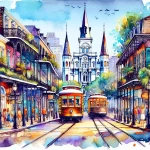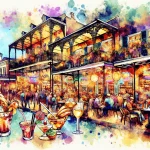New Orleans captivates visitors with its unique cultural blend of French, Spanish, and African influences. However, beneath its lively facade lies a darker side – a world of haunting tales and eerie legends that have solidified its reputation as one of America’s most haunted cities. With a history marked by tragedies like devastating fires, epidemics, and violent conflicts, New Orleans has embraced its supernatural allure.
In This Article
TL;DR
- New Orleans is widely recognized as one of the most haunted cities in the United States, brimming with ghostly narratives and unsettling legends.
- Responsibly and respectfully exploring haunted sites is crucial, as many locations hold significant historical and cultural importance.
- The French Quarter, St. Louis Cemetery No. 1, haunted bars on Bourbon Street, and nearby plantations offer a variety of spooky experiences.
The French Quarter: Ghosts of Old New Orleans
The French Quarter, the heartbeat of New Orleans, is a treasure trove of haunted sites and chilling stories. This historic neighborhood, with its narrow streets and centuries-old buildings, has witnessed countless tragedies and supernatural occurrences over the years.
One of the most infamous haunted locations is the LaLaurie Mansion, a grand residence that once belonged to the notorious Madame Delphine LaLaurie. Rumors of her cruelty towards her slaves led to the discovery of a gruesome torture chamber, and it is said that the spirits of her victims still linger within the walls.
Another iconic haunted spot is the Hotel Monteleone, a luxurious establishment that has been in operation since 1886. Guests have reported encountering the ghost of a former employee, Maurice, as well as unexplained noises and flickering lights. The hotel’s revolving carousel bar is said to be a hotspot for paranormal activity.
St. Louis Cemetery No. 1: City of the Dead
St. Louis Cemetery No. 1, one of the oldest and most famous cemeteries in New Orleans, is a must-visit destination for those seeking a haunting experience. Established in 1789, this “City of the Dead” is renowned for its above-ground tombs and the legendary voodoo queen, Marie Laveau, whose final resting place has become a pilgrimage site for many.
Visitors can explore the cemetery’s labyrinth of narrow paths, adorned with intricate tomb carvings and weathered statues, while learning about the city’s rich history and voodoo traditions. Guided tours are highly recommended to ensure a respectful and informative experience.
The Haunted Bars of Bourbon Street
Bourbon Street, the epicenter of New Orleans’ vibrant nightlife, is not just a hub for revelry but also a hotbed of ghostly activity. Two of the most famous haunted bars on this iconic street are Lafitte’s Blacksmith Shop Bar and Pat O’Brien’s.
Lafitte’s Blacksmith Shop Bar, dating back to the 18th century, is rumored to be haunted by the spirits of former patrons, including pirates and smugglers. Visitors have reported encountering unexplained cold spots, disembodied voices, and even the ghostly apparition of a woman in a red dress.
Pat O’Brien’s, a beloved piano bar, is said to be haunted by the ghost of a former employee named Munro. Guests have reported encountering his spirit, often accompanied by the scent of his favorite pipe tobacco.
Ghost Tours: A Guided Experience
For those seeking a more immersive and educational experience, New Orleans offers a wide range of ghost tours. From walking tours through the French Quarter to carriage rides and bus tours, these guided excursions provide a unique opportunity to explore the city’s haunted history.
Experienced tour guides regale visitors with chilling tales and historical accounts, bringing the city’s ghostly past to life. Many tours incorporate stops at famous haunted locations, allowing participants to witness firsthand the sites where supernatural occurrences have been reported.
Haunted Plantations Near New Orleans
Beyond the city limits, New Orleans is surrounded by several historic plantations, some of which are said to be haunted by the spirits of those who lived and worked there during the era of slavery.
One of the most renowned haunted plantations is the Myrtles Plantation, located about an hour’s drive from New Orleans. This antebellum estate is rumored to be one of the most haunted places in America, with reports of ghostly apparitions, unexplained footsteps, and even a haunted mirror.
Safety and Etiquette in Haunted Locations
While exploring New Orleans’ haunted sites can be an exhilarating experience, it is crucial to prioritize safety and respect local customs and regulations. Many of these locations are private properties or historic landmarks, and visitors should exercise caution and follow any posted rules or guidelines.
It is advisable to avoid trespassing or engaging in any disruptive behavior that could potentially damage these sites or disturb the spirits that are said to reside there. Additionally, nighttime visits should be undertaken with proper precautions, such as carrying flashlights and staying in well-lit areas.
The Role of Folklore and Storytelling in New Orleans’ Haunted Sites
New Orleans’ haunted sites are not merely physical locations but also repositories of rich folklore and storytelling traditions. The city’s unique cultural blend, woven from African, French, Spanish, and Native American influences, has given rise to a variety of ghost stories and supernatural tales.
Local storytellers and tour guides play a vital role in preserving and perpetuating these narratives, captivating audiences with their vivid descriptions and interpretations of the city’s haunted history. Through their storytelling, the boundaries between fact and fiction blur, creating an atmosphere of mystery and intrigue that adds to the allure of these haunted sites.
Impact of Haunted Tourism on New Orleans
Haunted tourism has become a significant economic driver for New Orleans, attracting visitors from around the world who are eager to experience the city’s supernatural side. This influx of tourism has not only contributed to the local economy but has also played a crucial role in preserving and maintaining many of the city’s historic sites and landmarks.
However, as with any form of tourism, it is essential to strike a balance between capitalizing on the city’s haunted reputation and respecting the cultural and historical significance of these locations. Responsible tourism practices and community engagement are key to ensuring that New Orleans’ haunted sites are preserved for future generations while also honoring the city’s rich heritage.






